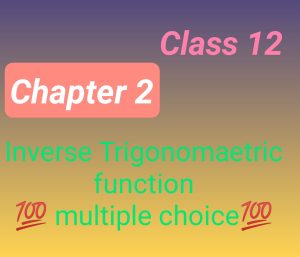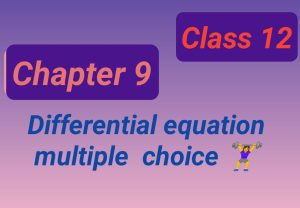Multiple choice (3 Dimensional Geometry)
` Choose and write the correct option in the following question:(Multiple choice question of 3 dimensional geometry)
1.) The co-ordinates of the foot of the perpendicular drawn from the point (2, -3, 4) on the y-axis is
(a) (2, 3, 4) (b) (-2, -3, -4)
(c) (0, -3, 0) (d) (2, 0, 4)
Answer (c)
2.) If a lines makes angles α, β and γ with the axis respectively, then ![]()
(a) -2 (b) -1
(c) 1 (d) 2
Answer (b)
3.) Distance of the point (α, β, γ) from y-axis is
(a) β (b) |β|
(c) |β|+|γ| (d) √(α²+γ²)
Answer (d)
4.) If the direction cosines of a line are k, k, k then
(a) k > 0 (b) 0 < k < 0
(c) k = 1 (d) ![]() or
or ![]()
Answer (d)
5.) The angle between the two diagonals of a cube is
(a) 30° (b) 45°
(c) ![]() (d)
(d) ![]()
Answer (d)
6.) If a line makes angles α, β, γ, δ with four diagonals of a cube, then
![]() is equal to
is equal to
(a) 1/3 (b) 2/3
(c) 4/3 (d) 8/3
Answer (c)
7.) If a line makes angle π/3 and π/4 with x-axis and y-axis respectively,then the angle made by the line with z-axis is
(a) π/2 (b) π/3
(c) π/4 (d) 15π/12
Answer (b)
8.) P is a point on the line segment joining the points (3, 2, -1) and (6, 2, -2). If x-coordinate of P is 5, then its y co-ordinate is
(a) 2 (b) 1
(c) -1 (d) -2
Answer (a)
9.) If α, β, γ are the angles that a line makes with the positive direction of x, y, z axis, respectively. then the direction cosines of the line are
(a) ![]()
(b) ![]()
(c) ![]()
(d) ![]()
Answer (b)
10.) The distance of a point P(a, b, c) from x-axis is
(a) ![]() (b)
(b) ![]()
(c) ![]() (d)
(d) ![]()
Answer (c)
11.) The equation of x-axis in space are
(a) x = 0, y = 0 (b) x = 0, y = 0
(c) x = 0 (d) y = 0, z = 0
Answer (d)
12.) A line makes equal angles with co-ordinate axis. Direction cosine of this line are
(a) ±(1, 1, 1) (b) ±(1/√3, 1/√3, 1/√3)
(c) ±(1/3, 1/3, 1/3) (d) ±(1/√3, -1/√3, -1/√3)
Answer (b)
13.) The distance of the point (1, 6, 3) to the line ![]() is
is
(a) √13 (b) 13
(c) 2√13 (d) None of these
Answer (a)
14.) The two lines x = ay + b, z = cy + d and x = a’y + b’, z = c’y + d’ will be perpendicular, if and only if
(a) aa’ + cc’ + 1 = 0 (b) aa’ + bb’ + cc’ + 1 = 0
(c) aa’ + bb’ + cc’ =0 (d) (a + a’)(b + b’)(c + c’) = 0
Answer (a)
15.) The area of the quadrilateral ABCD where A(0, 4, 1), B(2, 3, -1), C(4, 5, 0) and D(2, 6, 2) is equal to
(a) 9 sq.units (b) 18 sq.units
(c) 27 sq.units (d) 81 sq.units
Answer (a)
16.) The straight line ![]() is
is
(a) Parallel to x-axis (b) Parallel to y-axis
(c) Parallel to z-axis (d) Perpendicular to z-axis
Answer (d)
17.) The shortest distance between the lines given by ![]() and
and ![]() is
is
(a) 7 units (b) 2 units
(c) 14 units (d) 3 units
Answer (c)
18.) The image of the point (1, 6, 3) in the line ![]() is
is
(a) (2, 0, 5) (b) (1, 3, 4)
(c) (1, 0, 7) (d) (-3, -2, 0)
Answer (c)
19.) The shortest distance between the line ![]() and the y -axis is
and the y -axis is
(a) 1/5 (b) 1
(c) 0 (d) 12/5
Answer (d)
20.) The co-ordinates of the foot of perpendicular drawn from point A (1, 8, 4) to the line joining the points B(0, -1, 3) and C (2, -3, -1) are
(a) (-7/3, 2/3, 11/3) (b) (-5/3, 2/3, 19/3)
(c) (4/3, 2/3, 11/3) (d) None of these
Answer (b)









